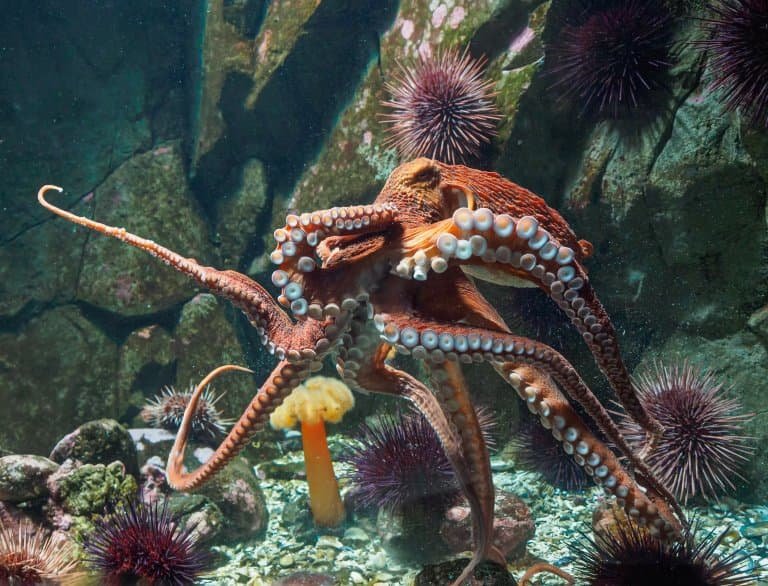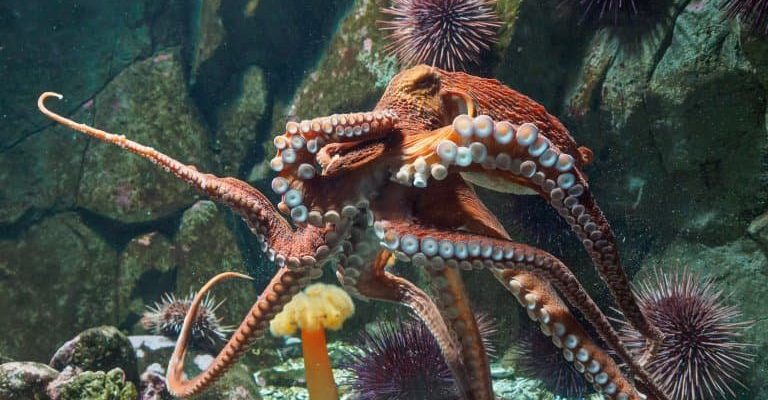
The giant Pacific octopus is the largest species of octopus in the world, typically found in the Pacific Ocean along the coasts of North America and Asia. They’re known for their extraordinary intelligence and unique physical features. Let’s explore some captivating facts about these incredible cephalopods that will leave you in awe. Who knows, you might end up wanting to learn more about their underwater lives!
1. Size Matters: The Scale of the Giant Pacific Octopus
When we talk about size, we’re not kidding. The giant Pacific octopus can weigh up to 110 pounds (50 kg) and stretch nearly 14 feet (4.3 meters) from arm to arm! Imagine an octopus that can rival a small car in size. This makes them truly extraordinary compared to other octopus species. Honestly, they remind me of a playful puppy that just keeps growing—there’s always more to love!
Their large size comes with some incredible adaptations. For instance, they have eight arms, each lined with hundreds of suckers that help them grasp onto rocks, prey, and even their mates. These suckers are not just for holding on; they can taste the environment too. So when a giant Pacific octopus goes exploring, it’s like a toddler discovering the world all over again—curious and eager to learn.
2. Masters of Disguise: Camouflage Skills
Have you ever played hide-and-seek? The giant Pacific octopus takes that game to a whole new level. They can change their skin color and texture almost instantly, blending in perfectly with their surroundings. This ability is thanks to special cells called *chromatophores*, which contract and expand to create different colors and patterns.
Imagine diving into the ocean and spotting a rock, only to realize it’s actually a giant octopus lying still! This skill is not just for fun; it helps them evade predators and ambush prey. Whether it’s a crab scuttling by or a fish swimming too close, an octopus can pull off the ultimate magic trick: disappearing right before your eyes!
3. Brilliant Problem-Solvers: Intelligence and Learning
You might be wondering how smart an octopus can really be. The giant Pacific octopus is known for its incredible intelligence. Studies have shown that they can solve puzzles, open jars to access food, and even escape from their tanks in aquariums. It’s like they’ve got their own secret language and tricks up their sleeves!
One fascinating story involves an octopus named Inky, who escaped from his enclosure at the National Aquarium of New Zealand. He wriggled through a small gap, made his way across the floor, and slipped into the ocean! This intelligence shows they’re not just mindless creatures floating around; they think and adapt like the rest of us.
4. Short but Sweet Lifespan
Here’s the thing: while giant Pacific octopuses are impressive in size and intelligence, they have a rather short lifespan. Most live only about 3 to 5 years. This might sound sad, but their lives are filled with intense experiences. They grow quickly, mature in about a year, and focus on reproduction in their final months.
Once they mate, females lay thousands of eggs and protect them without eating until they hatch. After the eggs hatch, the female usually dies shortly after. It’s a bittersweet ending, like a beautiful sunset that signals the end of a day. Despite their short lives, their impact on the marine ecosystem is significant.
5. A Unique Diet: What Do They Eat?
What do you think a giant Pacific octopus likes to munch on? These octopuses are carnivores, mainly feeding on crabs, fish, and even other octopuses. Their diet is essential for keeping the undersea food chain balanced. With their strong beaks, they can easily break through hard shells to get to the tasty meat inside.
Interestingly, they are also known to be a bit adventurous with their meals. An octopus can use its incredible flexibility to squeeze into tight spaces to hunt. Picture them reaching into a crevice, grabbing a crab, and promptly disappearing back into the shadows—talk about a successful dinner!
6. Incredible Reproduction: A Mother’s Love
The reproductive habits of giant Pacific octopuses are as fascinating as they are touching. After mating, females choose a hidden spot to lay their eggs. This can be a cave or a crevice where she feels safe. Over the next few months, she cares for her eggs, gently blowing water over them to keep them clean and oxygenated.
During this time, the mother octopus stops eating entirely. It’s a profound act of devotion, giving everything to ensure the survival of her young. Once the eggs hatch, she has spent all her energy; sadly, she dies shortly after. It’s a poignant reminder of the circle of life, emphasizing the intensity of nature’s beauty.
7. Smooth Swimmers: Their Unique Movement
If you ever get the chance to see a giant Pacific octopus in action, you’ll notice something special about how they swim. Unlike fish that propel themselves with fins, these octopuses use a method called *jet propulsion*. They fill their bodies with water, then forcefully expel it through a siphon, propelling them forward.
This movement is not just efficient; it’s also elegant. Imagine a dancer making graceful, flowing movements across the stage. An octopus can dart quickly when needed, making them skilled predators. Plus, if they want to move slowly and blend in, they can simply glide along the ocean floor, giving them the best of both worlds.
8. Habitat and Distribution: Where They Live
The giant Pacific octopus is mostly found in the coastal waters of the North Pacific Ocean, particularly off the coasts of Alaska, Canada, and the Pacific Northwest of the United States. They prefer rocky ocean floors or areas with plenty of nooks and crannies where they can hide and hunt.
These octopuses are known to be solitary creatures, often marking their territory. Imagine being the solo artist of the ocean, painting your masterpiece while ensuring no one intrudes. Their habitats are essential not just for them but also for the diversity of life they support.
9. Conservation Status: Protecting the Giants
Despite their impressive features, giant Pacific octopuses face threats just like many other marine creatures. Their populations are affected by factors such as *overfishing*, habitat destruction, and pollution. While they are currently not listed as endangered, maintaining a healthy ocean ecosystem is crucial for their survival.
As we learn more about these unique animals, awareness grows about how to protect their habitats. It’s like having a big family; everyone needs to work together to ensure that the little ones thrive and grow in a safe environment.
10. Fascination with the Giant Pacific Octopus
The giant Pacific octopus has captivated scientists, marine biologists, and ocean enthusiasts alike. Their intelligence, unique adaptations, and fascinating life cycles make them a subject of study and admiration. Documentaries and aquariums highlight their behaviors, inspiring many to learn more about marine life.
Ultimately, they remind us of the beauty and complexity of ocean ecosystems. So the next time you hear about the giant Pacific octopus, think of its incredible story, from its impressive size to its role in the underwater world. They’re not just creatures of the sea; they’re symbols of nature’s magic.
In summary, the giant Pacific octopus is a marvelous marvel of the ocean. Their mysterious lives are filled with surprising skills and heartfelt moments, leaving us to appreciate the rich tapestry of life beneath the waves. We’re lucky to share this planet with such extraordinary beings!

